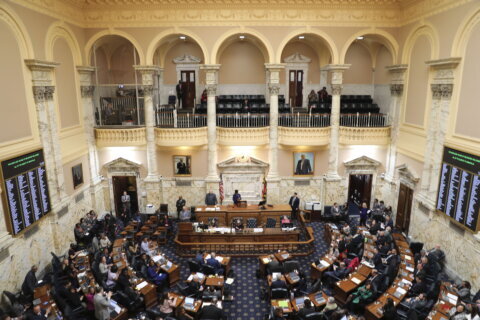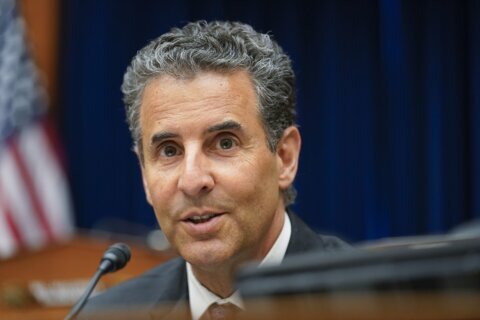A lot is riding not only on the presidential race this year, but also on the battle for control of the U.S. Senate.
Incumbents and challengers across the country are raising unprecedented amounts of money, and the party that will end up in power could turn on just a handful of fiercely fought contests.
- Q:
What is the current balance of power?
- A:
Republicans currently hold a 53-47 edge over Democrats. The Democrats need a net gain of three seats to have a majority, if Joe Biden is elected. (The vice president casts the deciding vote.) Democrats would need to gain four seats to gain control if President Trump is re-elected.
Senate Majority Leader Mitch McConnell has held the upper chamber’s top post since 2016, when Republicans regained control of the Senate. Maine Sen. Angus King and Vermont Sen. Bernie Sanders are Independents, but they caucus with Democrats.
- Q:
What’s at stake for the Senate and the courts?
- A:
McConnell has guided the Republican-led Senate as it has confirmed more than 200 federal judges nominated by President Trump. His latest success will likely be getting the confirmation of Judge Amy Coney Barrett to the U.S. Supreme Court. She would be the third conservative judge approved by the Senate to the high court since Trump came into office, following Justices Brett Kavanaugh and Neil Gorsuch.
Democrats have been unable to get enough votes to slow Barrett’s confirmation, which will likely take place with a Senate vote just days before the election. McConnell has been sharply criticized by Democrats for blocking a vote on President Obama’s nomination of Merrick Garland, following the death of Justice Antonin Scalia in February 2016. Republicans argued that the presidential election should be held before a Senate vote that year. They reversed themselves this year, after the death of Justice Ruth Bader Ginsburg.
- Q:
How many Senate seats are up for election?
- A:
A total of 35 Senate seats are at stake this year, and Republicans are on the defense. The GOP is trying to hold onto 23 seats currently held by Republicans, while 12 are held by Democrats.
While many incumbents will easily be re-elected, there are 10 especially close races that could determine which party controls the Senate after the election. Eight involve incumbent Republicans and two involve incumbent Democrats.
- Q:
What are some key races to watch?
- A:
North Carolina
The race between Republican Sen. Thom Tillis and Democratic challenger Cal Cunningham is the most expensive in the country, largely because this single race could ultimately determine whether Republicans retain power in the Senate or lose it to the Democrats. Including spending from outside groups, more than $200 million has been spent on advertising alone, making it the most expensive Senate contest in U.S. history.
Current polls show Cunningham with a slight lead, though he’s had to deal with recent media coverage related to allegations of an extramarital affair. Tillis was kept off the campaign trail for about 10 days, after announcing Oct. 2 that he had tested positive for COVID-19.
Maine
Longtime Republican Sen. Susan Collins is in the toughest fight of her political career against Democratic state House Speaker Sara Gideon.
Democrats are reminding voters that Collins voted for Justice Brett Kavanaugh to the Supreme Court in 2018. Collins is trying to walk a political tightrope and has said she will not vote for Barrett if the Senate floor vote takes place before Election Day, because she believes the presidential election should be decided first.
Colorado
Republican Sen. Cory Gardner has some of the challenges that Collins has. His state is split between heavily Republican rural areas and sprawling urban areas trending for Democrats, like those around Denver.
Unlike Collins, he has committed to voting to confirm Amy Coney Barrett to the Supreme Court. Gardner is running against former Gov. John Hickenlooper. The latest polls show Hickenlooper with a widening lead over Gardner. Polls there also show Joe Biden with a significant lead over President Trump.
Alabama
Sen. Doug Jones has widely been considered the most vulnerable Democrat. He faces an uphill battle in the red state, running against Republican Tommy Tuberville, the former head football coach at Auburn. Democrats had a surprise pickup with Jones in a 2017 special election, as he defeated controversial judge Roy Moore. If Jones loses, Democrats will need a net gain of four or five seats to get control of the Senate.
Arizona
Republican Sen. Martha McSally has been a vocal supporter of President Trump. But she’s recently been trying to put some distance between herself and the White House, with the president’s polling numbers dropping in Arizona. During a debate with Democratic challenger Mark Kelly, she recently declined to give an answer when asked if she’s proud of her support for Trump.
Polls have consistently shown Kelly leading in the race for the Senate seat, which is a special election, to complete the final two years of the term of the late Sen. John McCain. Kelly is a former NASA astronaut and the husband of former Rep. Gabrielle Giffords.
- Q:
Any other races to watch?
- A:
Iowa Republican Sen. Joni Ernst is in a tight race with Democratic challenger Theresa Greenfield. Ernst gained some unwanted attention after she flubbed a response on the break-even price of soybeans – a political no-no in farm country.
Georgia has two Senate races, including a close one between Republican Sen. David Perdue and Democrat Jon Ossoff. The other race will likely end up in a runoff. The three front runners are the Democratic candidate, Rev. Raphael Warnock, and two Republicans, Sen. Kelly Loeffler and Rep. Doug Collins.
Michigan Democratic Sen. Gary Peters has consistently led in polls over Republican challenger John James, but one of the newest polls suggests the race may effectively be a tossup.
In Virginia, Democratic Sen. Mark Warner is being challenged by Republican Daniel Gade. Polls have shown Gade trailing in the double digits.








